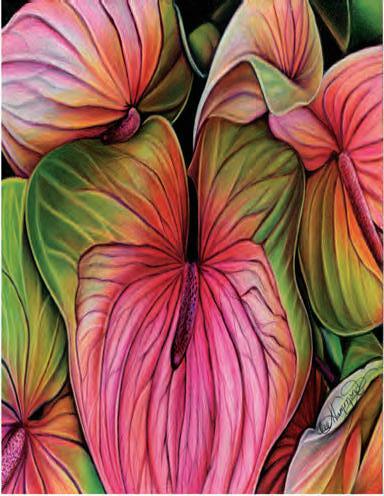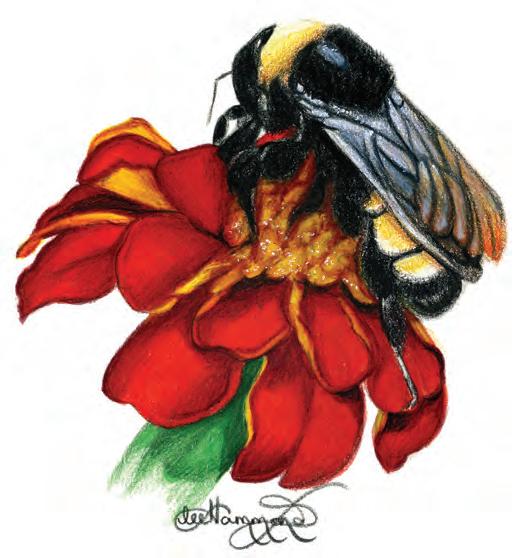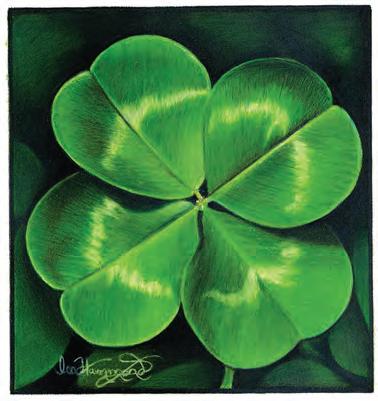
8 minute read
Introduction: The Beauty of Nature
Contents
Introduction: The Beauty of Nature | 6
Advertisement
1. Getting Started | 12
Pencils......................................... 13 Colors ......................................... 14 Drawing Paper ................................ 16 Other Tools.................................... 17
2. Basic Techniques | 18
Comparing Layering and Burnishing ........ 19 Demo: Drawing a Rock ....................... 21 Demo: Drawing a Cherry Tomato ........... 22 Demo: Drawing an Orange .................. 23
3. Composition, Color, Shapes, and Shading | 24
Composition ................................. 25 Color ......................................... 26 Shapes and Shading......................... 28 Demo: Drawing an Egg...................... 30 Demo: Drawing Colored Eggs ............... 31 Other Things to Remember ................. 32 Enjoy the Journey ........................... 33
4. Capturing Your Image on Paper | 34

The Grid Method............................. 35 Using a Viewfinder........................... 36 Segment Drawings .......................... 37 Try Different Viewfinders.................... 38
5. Drawing Fruits and Vegetables | 40
Different Views ............................... 41 Different Backgrounds ...................... 42 Different Paper Colors....................... 43 Demo: Drawing a Pear ...................... 44 Demo: Drawing a Tomato Close Up ........ 46 Demo: Drawing an Apple Close Up......... 48
6. Drawing Lovely Leaves | 50
Vein Details ................................... 51 Lights and Darks............................. 52 Exaggerating Color .......................... 53 Demo: Drawing a Sea Grape Leaf........... 54 Demo: Drawing Waterdrops on a Leaf ..... 56 Leaf Details .................................. 58 Succulents ................................... 60 Demo: Drawing a Succulent................. 60 Different Paper Colors....................... 62 Different Approaches........................ 63 Start Simple, Graduate to More Complex .. 64
7. Drawing Trees | 66
Banyan Tree Details.......................... 67 Scratching for an Illusion of Realism........ 68 Demo: Drawing and Scratching Foliage .... 69 Tree Trunk Details............................ 70

8. Drawing Beautiful Flowers | 72
Simple and Complex......................... 73 Demo: Drawing a Magnolia Bloom.......... 74 Demo: Drawing Waterdrops on a Petal..... 76 Demo: Drawing a Rose Step-by-Step ...... 78 Different Paper Colors....................... 80 No Two Alike.................................. 81 Shading Details .............................. 82 Light and Shadow ........................... 83 Shadow Edges ............................... 84 Extreme Shadows ........................... 85 Demo: Drawing a Bird of Paradise .......... 86 From a Distance ............................. 88 Stay Curious ................................. 89
9. Drawing Butterflies, Bees, and Bugs | 90
Demo: Black Swallowtail Butterfly.......... 92 Different Paper Colors....................... 94 Different Approaches........................ 95 Demo: Drawing a Malachite Butterfly ...... 96 Bees .......................................... 98 Demo: Drawing a Bumblebee............... 98 Honey Bee Details .......................... 100 Other Garden Bugs .......................... 101
10: Drawing Birds | 102
Surrounding Details and Basic Shapes .... 103 Demo: Drawing Parrot Feathers ........... 104 Adding Soft Pastel.......................... 106 Complementary Colors..................... 107 Demo: Drawing an Owl..................... 108 Macaw Details ............................... 110 A Different Viewpoint ....................... 112 Seabird Details............................... 113 Demo: Drawing a Blue Jay .................. 114 Drawing on Black ............................ 116 Telling a Story................................ 117 Demo: Drawing a Toucan.................... 118 White Gel Pen Details ...................... 120 Large Waterfowl ............................ 122 Birds Are Fascinating Subjects ............ 124
Conclusion | 125 Index | 126

Introduction: The Beauty of Nature
Each element of the great outdoors provides an artist with countless creative possibilities. There are endless ways to illustrate the beautiful colors and shapes found in nature. As one of my own quotes I have up in my studio states, “There is never a lack of subject matter, just absence of creativity.”
In this book, I've tried to create new ways of looking at all the aspects of nature with a more artistic eye. While I'm a realist in my work, I love exaggerating what I see, perhaps closing in on things for a closer view.
I want to provide you with a variety of ways to see things, to widen your perspective. While seeing things from an everyday point of view is often lovely as is, sometimes you need to change your vantage point. Within these pages, I provide different ways for you to imagine things within your artwork. From distant views to close-ups using extreme cropping techniques, this book will help you see things in a more creative and artistic way.
To enhance the colors in nature, I will show you how to exaggerate colors in your work, to make things more interesting, and to give your work a colorful glow. You will also learn how to use shadows and contrast for creating visual impact. No longer will you see things in the same run-of-the-mill fashion.
It’s time to try some new approaches and techniques on your colored-pencil journey. Take the projects in the order they appear, so you can develop your skills slowly, and learn as you go. Each project is designed to build on the previous ones and will show you new ways to master the medium of colored pencil.
I hope you’ll find this book fun and enjoyable. I also hope you’ll come to love drawing with colored pencil as much as I do! Good luck with your artistic journey!
—Lee

Good Luck! Four Leaf Clover, Prismacolor on Stonehenge paper, 7 ½" x 7". Colors used: Light Green, Chartreuse, Grass Green, Dark Green, Pale Aqua, Dark Brown, Black, White.
You Can Do It! Before and After
These are actual examples of a student’s progress while learning colored pencil for the first time. It shows the improvement acquired with some patience and practice. It takes time to develop a skill, and repetition is key. The more you do, the better you’ll get!
Before This first example was done by a student without having any previous experience with colored pencil. No help was given, and it was done beginning to end by her, without any advice or input from me. She did a great job for a beginner! Her shapes are good, and her color choices are on point. However, she was using a mixed batch of low-quality, student-grade colored pencils and a typical sketch pad.
After This second example shows how quickly she picked up the layering technique covered in this book after a demonstration from me. She used a grid (more on this later) to get the shapes accurate from her reference photo before she began. I also switched her to a higher quality of colored pencils (Prismacolor) and artist-quality drawing paper (Stonehenge). You can clearly see the difference in the quality of her work with just one lesson. She is now excited to pursue colored pencil as one of her favorite art materials. A whole new artistic world has opened up to her!


Two Important Techniques for Realism
I love colored pencil for its versatility. It provides artists with the ability to use many different techniques and approaches to create different looks and characteristics with their artwork. Colored pencils can create abstracts, impressionism, and super-detailed realism. A colored-pencil drawing can even be confused for a painting. The possibilities are endless, and experimentation is a wonderful experience. Here I’ll teach a more realistic approach with two distinctive techniques that will be the most important throughout.
Layering
Layering is a lighter approach to drawing with colored pencil. The drawing of the onion below was done using the layering technique. Layering is achieved by applying colored pencil in multiple, light layers, one on top of another. It is important to use a very sharp pencil point. With this technique, the texture of the paper shows through, helping to create the texture of the surface being drawn. The layering approach helps create the dull, crepe look of the onion skin. The visible pencil lines create the textured surface, as well as subtle color changes. Each color overlaps another, creating new colors.
Burnishing
Burnishing is a heavy approach to applying colored pencils. The tomato below was created using burnishing, which is done using dull pencils and firm pressure to completely cover the paper surface. Thick application of waxy color creates the look of a shiny surface and vivid color. By blending one color into another, it almost creates the look of paint. This burnishing approach is used anytime you want something to look slick and glossy.
Prismacolor on Stonehenge paper. Colors used: Beige, Yellow Ochre, Sunburst Yellow, Limepeel, Orange, Dark Brown, Jade Green, Black, White.
Prismacolor on Stonehenge paper. Colors used: Sunburst Yellow, Orange, Poppy Red, Crimson Red, Tuscan Red, Apple Green, Dark Brown, Black, White.

Layering and Burnishing Here are two subjects, both drawn with colored pencil on Stonehenge drawing paper. The onion was done with the layering technique, while the tomato was drawn with the burnishing technique.

Plan Your Viewpoint
Everything you draw will be a collection of elements—shapes, values (light and dark areas), and color. The colors in turn will always be depicted by local color (what the actual color of the object is), shadows, and highlights. It’s important to study these elements in your photo reference before you begin to draw. You need to know what you are actually seeing according to these elements. Having a plan as to how you want your finished artwork to appear will make it easier to focus on these key elements. Do you want to see it from afar, or up close and personal?
There are endless ways to portray your subjects. The choice is up to you. I never know how I’m going to draw something until I get ready to start and study my photo reference to understand the details. After I study my subject, I decide if I will enlarge it, crop it, or draw it just how I see it. It’s a different journey each time, and the look I create is never the same twice.
There are three basic visual perspectives: full view, average distance, and macro (or super close-up). Details appear different with each approach.
Super Close-up This example is an enlarged, cropped version of a photo I took of a rose. Rather than draw the whole thing, I wanted to focus on the flower’s velvety petals and show the glow of its beautiful colors and highlights.

Prismacolor on Strathmore drawing paper, 7" x 11". Colors used: Poppy Red, Scarlet Lake, Magenta, Tuscan Red, Neon Orange, Neon Pink, Imperial Violet, Violet.





